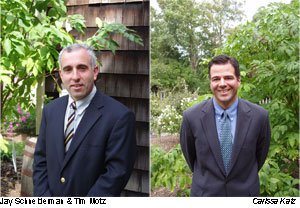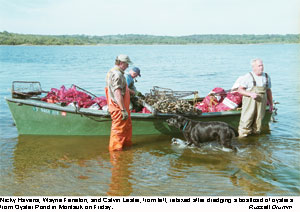JEWISH CENTER: Allegations Are Aimed At Rabbi-Serious accusations split a congregation
JEWISH CENTER: Allegations Are Aimed At Rabbi-Serious accusations split a congregation

Despite saying two weeks ago that it would wait until after the High Holy Days to share its evaluations of Rabbi David Gelfand with the congregation of the Jewish Center of the Hamptons, the center's board broke its silence on Friday with a damning six-page letter detailing its concerns about Mr. Gelfand's leadership.
"Your board has been reluctant to share with the congregation our reservations about Rabbi Gelfand until we had done our research and reached our final conclusion," the president of the board, Donald Zucker, wrote in an introductory letter to the 720 family and individual members of the congregation.
Mr. Zucker wrote that the board was unable to "keep the issues confidential," however, because supporters of the rabbi have demanded a special meeting on Oct. 9 to immediately extend his contract by three years past its June 2006 expiration.
The board has asked the Committee on Ethics and Appeals of the Central Conference of American Rabbis to help it find "the truth about certain facts, and to help us heal the division that threatens our congregation," the letter says.
Because it has taken the matter to the umbrella organization for Reform rabbis, the board "thought it would make sense for the congregation to understand why that was happening," Laura Hoguet, an attorney for the Jewish Center, said yesterday.
"Obviously we think there are substantial serious issues and that's why we put them in a letter to the C.C.A.R. and put them in a letter to the congregation," Ms. Hoguet said.
"We would have preferred not to have done this," Barnet Liberman, the chairman of the board's personnel committee, said yesterday. Before the rabbi's contract can be extended, "We need to have some answers and they're not forthcoming," he said.
In the letter, the board says that questions about the rabbi have arisen in the past year regarding financial discrepancies, potential plagiarism of sermons, use of membership files for "personal purpose," and treatment of staff, board members, and fellow clergy.
"On countless occasions and in countless ways, Rabbi Gelfand has made clear his disdain for the board's members, to the detriment of our community," Mr. Zucker wrote. He recalled that "During a recent service, while recounting the story of the camel as a horse developed by a committee, Rabbi Gelfand looked over to board members seated nearby and remarked for all to hear, 'or by a board of trustees.' "
According to Mr. Zucker, the board has "identified five events at which the rabbi and other clergy officiated after which the other clergy turned in an honorarium, but Rabbi Gelfand did not."
Coming just a week before the start of the Jewish holidays, the letters underscore a growing division between the board and the many members of the congregation who support the rabbi.
"I think it shows the kind of folks we have on the board that they would defame the rabbi the way they're doing it at this time of year," Mr. Gelfand's attorney, Michael Weber, said yesterday. Mr. Weber said he had made it clear to the board that "we would cooperate in all investigations," but that the board "never asked the rabbi for any comment" on the matters it was looking into.
"Any time he wants to come forward with information, we'll be happy to have it," Laura Hoguet, an attorney for the Jewish Center, said yesterday.
While the allegations made in the letter are considered serious, Mr. Barnet said the board is "not responding to or intimidated by threats of legal action based on slander or libel."
Since hearing earlier this summer that the board may not renew Rabbi Gelfand's contract when it expires next June, the rabbi's supporters have mounted an all-out campaign to keep him at the synagogue. They have circulated petitions and sent e-mails to congregants urging others to back the rabbi.
The board filed a complaint with East Hampton Village Police alleging that a former Jewish Center employee improperly accessed files containing the e-mail addresses of congregation members. No arrests were made. On Sept. 16, village police received a related complaint from Susan Pashman of Sag Harbor, a member of the center who also teaches there. Ms. Pashman told police that two members of the congregation obtained her e-mail address and that of other congregation members without authorization to do so.
Although the board has several months before it must make a decision on the rabbi's contract, his supporters forced the issue to the table at the center's annual meeting in August. After that meeting, Mr. Weber and the board began negotiations to extend the rabbi's contract. Mr. Weber said yesterday he believed at one point that an agreement had been reached, but that the board then changed its mind. Ms. Hoguet confirmed earlier this month that the board had deferred its decision on the contract.
The rabbi's supporters called a special meeting on Sept. 11 to vote themselves on whether the rabbi's contract should be extended. Over 200 people attended and others sent in proxies. The final tally, according to the organizers of the meeting, was 802 in favor of an extension and zero against.
Although they believe the meeting was called according to the center's bylaws and that only the members have the right to hire or fire a rabbi, the board has not recognized the legitimacy or results of the Sept. 11 meeting.
Those at the meeting also signed a petition demanding another special meeting on Oct. 9, midway between Rosh Hashana and Yom Kippur, to direct the board to execute that contract extension.
The board has asked the rabbi and his supporters to delay that meeting until after the holidays. They have declined to do so.
Mr. Weber said Rabbi Gelfand will not respond to the charges in the board's letter until after the holidays.
"The rabbi is focusing on his rabbinical obligations and duties during this period of repentance," he said. However, his supporters expect to release a statement by the end of the week.
Ms. Hoguet said she does not believe the differences between the board and the rabbi's supporters are irreconcilable.
"People are hot under the collar now, but the issue will be clarified and settled. No one is irreplaceable," Mr. Barnet said. "I'm hoping that the Rabbi will assume his leadership position and guide the community through the holidays appropriately. . . . He's a good leader. I'd be disappointed if he didn't seize the opportunity to heal during this period."






